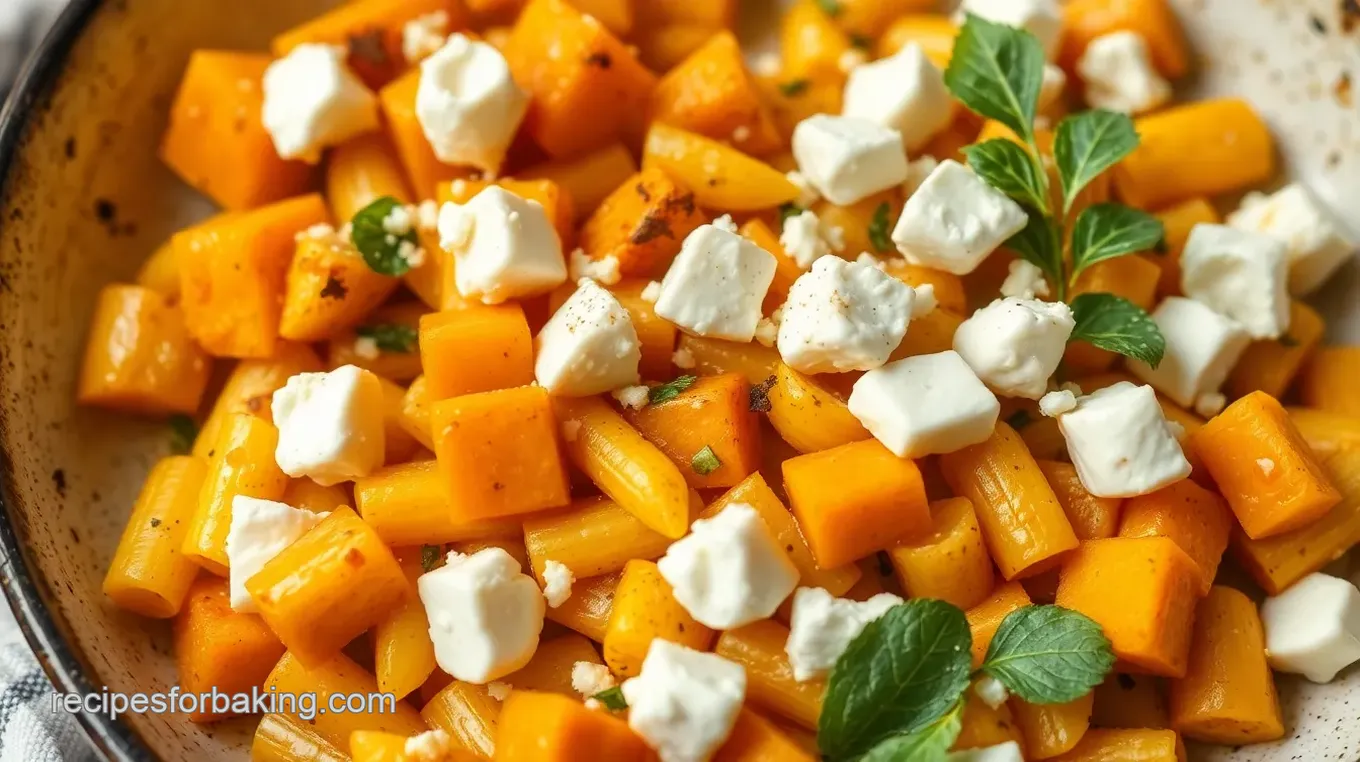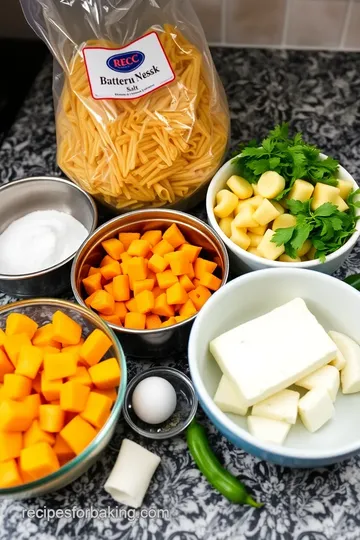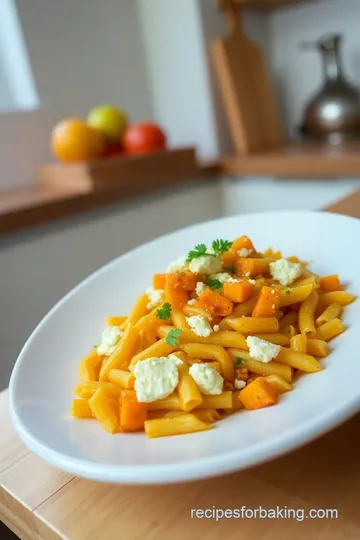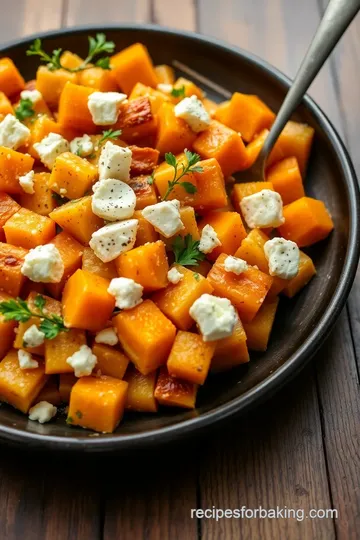Delicious Baked Feta Butternut Squash Pasta
Looking for a comforting meal? This Delicious Baked Feta Butternut Squash Pasta perfectly blends sweet squash and creamy feta for an unforgettable dinner. Give it a try!

- Finding Comfort in a Wholesome Dish
- The Delicious Journey Begins
- Feast Your Eyes on the Benefits
- Recipes That Bring Joy
- Your Go-To Guide for Essentials in Cooking
- Mastering Professional Cooking Techniques for Delicious Dishes
- Pro Tips & Secrets for Delicious Baked Feta Butternut Squash Pasta
- Perfect Presentation
- Storage & Make-Ahead Strategies
- Recipe Card
Finding Comfort in a Wholesome Dish
Oh my gosh, have you ever had one of those cozy nights when you just want to wrap yourself in a warm blanket, sip on something hot, and indulge in delicious baked feta butternut squash pasta ? i remember a rainy evening when i just wanted comfort food.
I stumbled upon the trending baked feta recipes and decided to give it a go. little did i know, i was about to create a masterpiece that would steal my heart!
You see, this dish combines the sweetness of roasted butternut squash with the creamy richness of baked feta cheese. it’s like a cozy hug for your taste buds! this recipe has a way of making every bite feel warm and happy.
Seriously, it’s the ultimate comfort food that everyone needs in their repertoire.
The Delicious Journey Begins
Let’s dive into the history a bit. the viral trend of baked feta recipes took social media by storm a few years back, and for a good reason! this simple pasta recipe brings a modern twist to mediterranean cuisine, combining all those flavors we love.
Fast forward to now, it's become a favorite in my home.
Most importantly, it’s easy ! you only need about 45 minutes from start to finish. that includes roasting the squash, boiling the pasta, and baking that feta to creamy perfection.
Plus, it makes enough to serve around four people, so it’s perfect for a family dinner or a gathering with friends.
And let’s not forget—cozy evenings with this dish? total game-changer!
Feast Your Eyes on the Benefits
Let’s chat about the benefits. first off, this pasta is packed with nutrient-rich goodness . butternut squash is full of vitamins, and we all know feta cheese brings the flavor! plus, it’s a vegetarian-friendly option, making it a great choice for meatless meals .
Want to impress your friends? serve it at your next gathering! it adds flair to any table, and everyone will be asking for seconds.
I love that you can whip it up on a weeknight or save it for a special occasion. it makes you feel fancy without all the fuss.
Oh, and it’s way better than regular pasta bake with feta. trust me, the flavor combinations are rich and savory, making it stand out amongst other creamy pasta dishes .
Recipes That Bring Joy
Honestly, one of my favorite parts about this dish is how versatile it is! you can customize it to fit your tastes.
Want an extra kick? toss in some red pepper flakes! prefer a different squash? go ahead; use sweet potatoes or acorn squash.
This recipe seamlessly adapts to whatever you have lying around. it’s all about creating flavorful pasta combinations that suit your mood.
And let’s be real here; there’s nothing better than that first bite of garlic butter pasta enveloping creamy feta and sweet squash.
The sheer joy of it is enough to make you dance in your kitchen (trust me, it happens)!
So, are you ready to create your own cozy evening with this amazing dish? The anticipation of gathering your ingredients and creating something delicious is part of the fun.
What are you waiting for? Let's jump into the ingredient list and make that magic happen!

Your Go-To Guide for Essentials in Cooking
Ah, the kitchen. the heart of the home, right? it's where we whip up everything from comfort food recipes to healthy pasta meals .
No matter if you’re a novice or a pro, knowing your essential ingredients can be your golden ticket to delightful dishes.
Let’s dive into the basics!
Premium Core Components
First up, let’s talk about the premium core components of your pantry. Quality ingredients make all the difference, whether you're making creamy pasta dishes or roasted vegetable goodness.
- Measurements Matter : For that perfect balance, always have your ingredients measured. Use 12 oz (340 g) of pasta, and remember, a little precision goes a long way!
- Quality Indicators : Not all pasta is created equal. Look for durable products. If you can bend it and it doesn't snap? You've got yourself a winner!
- Storage Guidelines : Store spices in a cool, dark place to keep them flavorful longer. Most dried herbs can last up to 1-3 years if stored well!
For freshness, always check for the expiration dates . Freshness tips? Sniff those herbs! If they’ve lost their aroma, it’s time to let them go.
Signature Seasoning Blend
Now, let’s spice things up a bit. A good signature seasoning blend is key for flavor nirvana.
- Essential Spice Combinations : Think basil and oregano together! Or how about some zesty red pepper flakes for that punch? Mix and match to create your personal blend.
- Herb Selections : Don't ignore the magic of fresh herbs like parsley or thyme. Pairing them with hearty dishes like our Delicious Baked Feta Butternut Squash Pasta can take it to the next level.
- Flavor Enhancers : A dash of garlic or a hint of lemon zest can wake up even the simplest of meals. Try it, trust me!
Smart Substitutions
Stuck without an ingredient? No worries! Let’s talk smart substitutions .
- Common Alternatives : If you're out of feta, use goat cheese instead. It’s creamy and adds that richness!
- Dietary Modifications : For gluten restrictions, opt for gluten-free pasta. Many brands have great tastes now.
- Emergency Replacements : Out of squash? Use sweet potatoes for a similar texture in those roasted dishes. You won’t miss a beat!
Kitchen Equipment Essentials
Next, let's chat about the kitchen equipment essentials . Trust me, you need the right tools for those easy family dinners .
- Must-Have Tools : A good pot and a solid baking dish are must-haves. They’ll serve double-duty for everything from pasta bake with feta to classic casseroles.
- Preparation Tips : Stash a good wooden spoon; it’s your best friend in mixing well.
- Storage Solutions : Invest in clear containers to store your grains. You’ll notice when you’re running low!
Wrapping It Up
Getting comfortable with your ingredients and tools will change your cooking game. Just think about it: you could be creating mouthwatering, homemade dishes like Delicious Baked Feta Butternut Squash Pasta quicker than ever!
Remember, the kitchen is a creative zone, so try things out! next up, i'm going to guide you through the instructions of preparing this delightful dish.
Trust me, it’ll be worth your while!

Mastering Professional Cooking Techniques for Delicious Dishes
So, you’re ready to step up your cooking game? whether you’re dreaming of serving a flawless delicious baked feta butternut squash pasta or just wanting to impress your family during a cozy dinner, mastering some professional cooking methods can make a huge difference! let's dive into the essential steps that will elevate your cooking skills from home cook to kitchen maestro.
Essential Preparation Steps
First things first: mise en place . this french phrase means "everything in its place." trust me, it makes a massive difference! gather all your ingredients—your chilled feta, cubed butternut squash, garlic, herbs—and have them prepped before you even turn on the heat.
Not only does this save time, but it also reduces stress. you won’t be scrambling for ingredients while your pasta boils.
Next up: time management . this is where cooking can sometimes feel like a race. plan out each step. for example, while your butternut squash is roasting—at a hot 400° f ( 200° c) —you can boil the pasta.
Don't forget about those moments to stir or check if your squash is nice and tender after about 20- 25 minutes .
Organize your workspace! keep everything neat and in reach. i can’t tell you how many times i’ve searched for that one ingredient only to realize it’s buried under a bunch of stuff.
A clean, organized kitchen lets you stay focused.
Safety is key, too. always handle knives carefully and make sure to use separate cutting boards for veggies and proteins to avoid cross-contamination.
Oh, and keep a towel handy to wipe up spills—trust me, your future self will thank you!
Step-by-Step Process
Let’s break it down with a clear, numbered guide to help you out:
-
Preheat your oven to 400° F ( 200° C) . Start your timer; cooking is all about timing!
-
Prepare your butternut squash . toss those cubes in olive oil, minced garlic, and your dried herbs. spread them on a baking sheet and roast for 20- 25 minutes until they’re tender and caramelized.
-
Cook your pasta next. Bring a large pot of salty water to a boil, and cook the pasta according to the package directions until al dente. Drain and set aside.
-
Time for the feta! when the squash is about halfway done, push it to the side and place your feta smack in the middle.
A drizzle of olive oil and some red pepper flakes on top never hurt anyone. bake for another 15 minutes until the feta is melted and lightly golden.
-
Combine everything . In that large pot, mix together your cooked pasta, roasted squash, and creamy feta. Toss it like you mean it!
-
Taste and adjust . A squirt of fresh lemon juice, a little salt and pepper can make all the difference in brightening your dish.
-
Serve it up ! Garnish with lemon zest and fresh parsley because presentation is key.
Expert Techniques
Want to take it up a notch? Here are a few pro tips .
When choosing your pasta, go for shapes like penne or fusilli that can catch that creamy sauce beautifully. and remember, when roasting your veggies, that high heat unlocks flavors by caramelizing natural sugars.
Check for doneness not just through time but visually. when those veggies start to brown, you know you’re on the right track.
And if something doesn’t come out right, don’t freak out! cooking is about experimenting. learn what went wrong, make notes, and try again.
Success Strategies
Let’s talk common mistakes. Don’t let your garlic burn; add it later in the cooking process to the squash to keep that wonderful flavor without the bitterness.
Quality assurance matters too. Taste your dish at every stage to see if it needs that extra pinch of salt or a kick from lemon juice.
And the best part about this? you can easily make the delicious baked feta butternut squash pasta ahead of time.
Prep everything in advance, and just heat it up when you’re ready to eat!
Additional Information
These professional cooking techniques not only help you navigate through complex recipes but also build a solid foundation for countless meals—like a go-to for cozy dinner recipes and vegetarian pasta recipes .
With a little practice, you’ll be whipping up creamy pasta dishes and savory baked pasta like a pro in no time.
Just remember, the heart of cooking is passion, a little patience, and maybe a dash of improvisation. happy cooking!

Pro Tips & Secrets for Delicious Baked Feta Butternut Squash Pasta
Alright, friends, let’s dive into some pro tips for crafting that delicious baked feta butternut squash pasta . this isn't just any pasta dish; it's packed with flavor and cozy goodness! here are some insights straight from my own kitchen escapades.
Chef's Personal Insights
First things first, keep it simple . when you’re roasting that butternut squash, feel free to toss in other veggies too! i once added some brussels sprouts, and it totally took the vibe up a notch.
Just think of it as a free-for-all of roasted goodness!
Time-Saving Techniques
Now, if you’re short on time (who isn’t, right?), consider chopping your butternut squash the night before. just stash it in the fridge and you can hit the ground running.
Prepping the pasta and squash ahead makes for a quick weeknight dinner. plus, you can spend that extra time binge-watching your favorite show!
Flavor Enhancement Tips
Don’t skimp on the herbs! the oregano and thyme are non-negotiable if you want that deep flavor profile. a little sprinkle of garlic powder can also pump up the savory baked pasta vibe without adding extra prep time.
Honestly, who can say no to more garlic? i’m all about that garlic butter pasta life!
Presentation Advice
When your pasta’s ready, let’s talk presentation . simple plating goes a long way. use a big bowl and heap those vibrant colors right in the center.
A good garnish of fresh parsley and some lemon zest on top creates a gorgeous contrast that’ll have everyone reaching for their phones to snap a pic.
I mean, it’s not every day you whip up a dish that looks as good as it tastes, am i right?
Perfect Presentation
Now that we’ve tackled some pro tips, let’s get into perfect presentation for your delicious creation.
Plating Techniques
Layering is key. Place a generous scoop of creamy pasta down first, and gently top it with roasted butternut squash and that dreamy baked feta.
Garnish Ideas
For a pop of color and freshness, sprinkle some fresh parsley or even some toasted pine nuts. Not only does it look fancy, but it adds different textures too!
Color Combinations
Butternut squash gives that warm orange hue, while the feta adds stark white. mixing those with some green from herbs creates a beautiful dish that you just can’t resist.
Trust me; your dinner guests will be impressed!
Visual Appeal Tips
Lighting is everything! Natural light is your best friend for those food pics. So, if you’re trying to snap a shot, head toward a window and let that beauty shine!
Storage & Make-Ahead Strategies
Alright, so life happens, and sometimes, we gotta think about storage and make-ahead options for our pasta dish. Here’s how you can keep it fresh.
Storage Guidelines
If you have leftovers (major win!), store your pasta in an airtight container. it’ll stay fresh for about 3 to 4 days in the fridge, but let’s be real—good luck with that, especially if it’s made its way to the dinner table.
Preservation Methods
For longer storage, consider freezing. Just make sure to let it cool completely before transferring to the freezer. Warm pasta and freezers don’t mix well!
Reheating Instructions
When you're ready to dig in again, just pop it in the microwave, or heat up in a pan on the stove.
If it seems dry, a splash of olive oil or a touch of milk can bring back that creaminess. it’s like a creamy baked pasta recipe all over again!
Freshness Duration
Keep an eye on your pasta; try to enjoy it within a week for the best taste. It’s pasta, not fine wine after all!
So, there you have it! whether you're enjoying this delicious baked feta butternut squash pasta alone on a cozy night or serving it up for a gathering, these little tips will keep things fun and stress-free.
Remember, cooking is about experimentation and joy, so don’t sweat the small stuff. look into into the world of easy family dinners and make this pasta your own! happy cooking!
Delicious Baked Feta Butternut Squash Pasta Card

⚖️ Ingredients:
- 12 oz (340 g) pasta (penne or fusilli)
- 2 cups (about 280 g) butternut squash, peeled and cubed
- 8 oz (225 g) feta cheese, block or crumble
- 3 tablespoons olive oil
- 4 cloves garlic, minced
- 1 teaspoon dried oregano
- 1 teaspoon dried thyme
- Salt and black pepper, to taste
- Fresh parsley, for garnish (optional)
- ½ teaspoon red pepper flakes (optional)
- Zest of 1 lemon
- Fresh lemon juice, to taste
🥄 Instructions:
- Step 1: Preheat your oven to 400°F (200°C).
- Step 2: In a mixing bowl, toss cubed butternut squash with olive oil, minced garlic, oregano, thyme, salt, and pepper. Spread on a baking sheet and roast for 20-25 minutes until tender.
- Step 3: In a large pot, boil salted water. Cook pasta according to package instructions until al dente. Drain and set aside.
- Step 4: On the same baking sheet, push the squash to the side and place the feta block in the center. Drizzle with a little olive oil, and sprinkle with red pepper flakes (if using). Bake for an additional 15 minutes, until the feta is soft and slightly golden.
- Step 5: In a large pot, combine cooked pasta, roasted butternut squash, and melted feta (it should be creamy). Toss to combine.
- Step 6: Taste and adjust seasoning with more salt, pepper, and lemon juice to brighten the flavors.
- Step 7: Garnish with lemon zest and fresh parsley before serving.
Previous Recipe: Easy Baked Feta and Blueberries: Irresistibly Creamy Treat to Savor
Next Recipe: My Grandmother's Baked Milk Flan: Creamy Delight in 1 Hour
